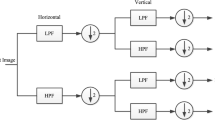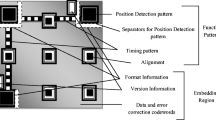Abstract
The Internet is used for exchanging information. Sometimes it is required to transmit confidential data over the internet. Here the authors use image steganography to embed confidential data within a cover image. To construct the technique, this article combines the help of Particle Swarm Optimization (PSO), Bi-Orthogonal Wavelet Transform (BWT) and Genetic Algorithm (GA). PSO is included to take the enhanced version of the host image. The enhanced version of the host images is more sharp and bright. Bi-Orthogonal Wavelet Transform is included to choose the selective sub-bands of the host image. Genetic Algorithm is used to select the fittest hidden image among a set of hidden images which are created after mutation. Later, the hidden image would produce a confidential password using an innovative technique. Thus an innovative technique of image steganography is introduced to transmit confidential data in a cover image. This combinational approach of image steganography is quite safe for confidential data transmission and really difficult for the attackers to retrieve the confidential data.








Similar content being viewed by others
References
Amsaveni A, Vanathi PT (2015) A comprehensive study on image steganography and Steganalysis techniques. Int J Inf Commun Technol 7(4/5):406–424
Bedi P, Bansal R, Sehgal P (2013) Using PSO in a spatial domain based image hiding scheme with distortion tolerance. Comput Electr Eng 39:640–654
Bhuiyan SSN, Malek NA, Othman Omran Khalifa OO, Rahman FDA (2018) An Improved Image Steganography Algorithm based on PVD. Indonesian Journal of Electrical Engineering and Computer Science 10(2):569–577. https://doi.org/10.11591/ijeecs.v10.i2.pp569-577
Carvalho RLD, Silva WGD, Morais AHOD (2017) Optimizing image steganography using particle swarm optimization algorithm. Int J Comput Appl 164(7):1–5. https://doi.org/10.5120/ijca2017913686
Chen L, Hu R, Liang C, Li Q, Han Z (2015) A novel face super resolution approach for Noisy images using contour feature and standard deviation prior. Multimed Tools Appl 76(2):2467–2493
Fakhredanesh M, Rahmati M, Safabakhsh R (2019) Steganography in discrete wavelet transform based on human visual system and cover model. Multimed Tools Appl 78(13):18475–18502
Ghasemi E, Shanbehzadeh J, Fassihi N (2012) High capacity image steganography based on genetic algorithm and wavelet transform, Intelligent Control and Innovative Computing, pp. 395-404, lecture notes in electrical engineering 110, 10.1007/978-1-4614-1695-1 30
Gu X, Sun Y (2018) Image transformation and information hiding technology based on genetic algorithm. EURASIP Journal on Image and Video Processing 2018:1–10. https://doi.org/10.1186/s13640-018-0348-9
Hemnath DJ, Anitha J, Popescu DE, Son LH (2018) A modified genetic algorithm for performance improvement of transform based image steganography systems. J Intell Fuzzy Syst 35(1):197–209. https://doi.org/10.3233/JIFS-169580
Hemnath DJ, Umamaheswari S, Popescu DE, Antoanela N (2016) Application of genetic algorithm and particle swarm optimization techniques for improved image steganography systems. Open Physics 14:452–462. https://doi.org/10.1515/phys-2016-0052
Kaur S, Jindal S (2017) Improve image steganography using random password generation for secure transmission of data. Proceedings of 5th International Conference on Advancements of Engineering & Technology
Kuar A, Kaur R, Kumar N (2015) Image steganography using discrete wavelet transform and artificial bee Colony optimization, 1st International Conference on Next Generation Computing Technologies, 10.1109/NGCT.2015.7375269
Kumar V, Kumar D (2018) A modified DWT-based image steganography technique. Multimed Tools Appl 77(11):13279–13308. https://doi.org/10.1007/s11042-017-4947-8
Lorente AS, Berres S (2017) A secure Steganographic algorithm based on frequency domain for the transmission of hidden information. Security and Communication Networks. https://doi.org/10.1155/2017/5397082
Maheswari SU, Hemanth DJ (2015) Performance Enhanced Image Steganography Systems using Transforms and Optimization Techniques. Multimed Tools Appl 76(1):415–436
Nosrati M, Hanani A, Karimi R (2015) Steganography in image segments using genetic algorithm. Fifth International Conference on Advanced Computing & Communication Technologies. https://doi.org/10.1109/acct.2015.57
Pramanik S, Bandyopadhyay SK (2013) Application of steganography in symmetric key cryptography with genetic algorithm. Int J Comput Technol 10(7):1791–1799. https://doi.org/10.24297/ijct.v10i7.7027
Pramanik S, Bandyopadhyay SK (2014) Image steganography using wavelet transform and genetic algorithm. International Journal of Innovative Research in Advanced Engineering 1(1):17–20
Pramanik S, Singh RP, Ghosh R (2019) A New Encrypted Method in Image Steganography. Indonesian Journal of Electrical Engineering and Computer Science 14(3):1412–1419. https://doi.org/10.11591/ijeecs.v13.i3.pp1412-1419
Saidi M, Hermassi H, Rhouma R, Belghith S (2017) A New Adaptive Image Steganography Scheme based on DCT and Chaotic Map. Multimed Tools Appl 76(11):13493–13510
Sanjutha MK (2018) An image steganography using particle swarm optimization and transform domain. International Journal of Engineering and Technology 7(2.24):474–477
Sung J, Choi BY, Ha YH (2014) Image Thresholding using standard deviation. Proceedings of SPIE - The International Society for Optical Engineering 9024. https://doi.org/10.1117/12.2040990
Sweldens W (1996) The lifting scheme: a custom design construction of biorthogonal wavelets. Appl Comput Harmon Anal 3(2):186–200
Author information
Authors and Affiliations
Corresponding author
Additional information
Publisher’s note
Springer Nature remains neutral with regard to jurisdictional claims in published maps and institutional affiliations.
Rights and permissions
About this article
Cite this article
Pramanik, S., Singh, R.P. & Ghosh, R. Application of bi-orthogonal wavelet transform and genetic algorithm in image steganography. Multimed Tools Appl 79, 17463–17482 (2020). https://doi.org/10.1007/s11042-020-08676-1
Received:
Revised:
Accepted:
Published:
Issue Date:
DOI: https://doi.org/10.1007/s11042-020-08676-1




